BUS509: Stewardship Construct Paper - Model Analysis and Critique
VerifiedAdded on 2022/10/15
|9
|2143
|486
Report
AI Summary
This report critically analyzes Block's stewardship model within the context of a non-profit organization, Headspace, as required for a BUS509 assignment. It begins by introducing the concept of stewardship leadership, contrasting it with traditional for-profit leadership models and highlighting the unique challenges faced by non-profit organizations. The report then delves into Block's model, emphasizing its focus on empowering employees, redistributing authority, and prioritizing service over dominance. A detailed discussion of the model's benefits, such as fostering intergenerational interchange and promoting accountability to future stakeholders, is provided. The report also acknowledges the model's limitations, including potential overemphasis on servant hood and the misinterpretation of authority. The analysis extends to the application of stewardship theory within Headspace, considering factors like agency controls, contractual obligations, and governance guidelines. The report concludes by summarizing the key aspects of Block's model and its implications for leadership within non-profit settings, emphasizing the importance of context, relational connections, and a culture of openness.
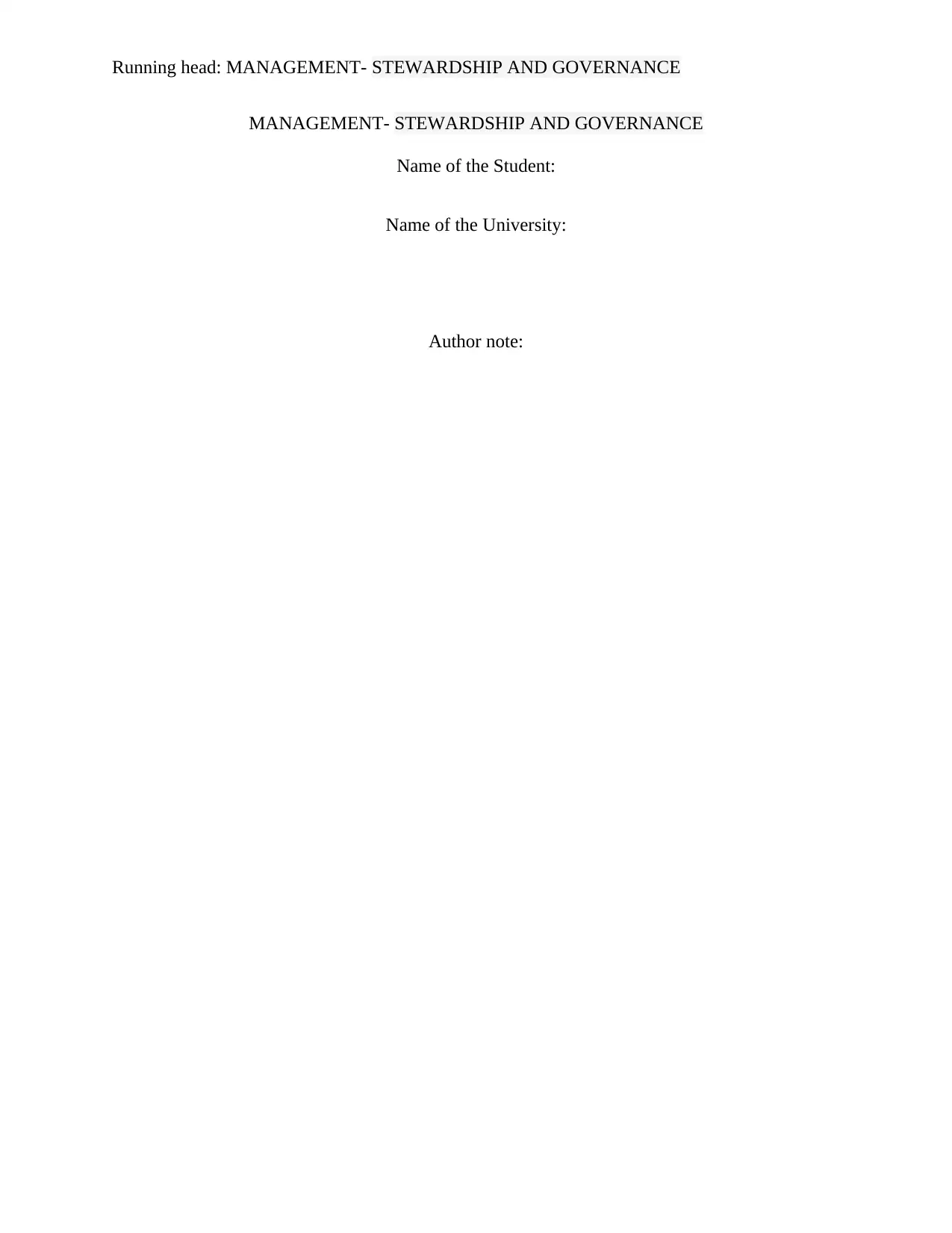
Running head: MANAGEMENT- STEWARDSHIP AND GOVERNANCE
MANAGEMENT- STEWARDSHIP AND GOVERNANCE
Name of the Student:
Name of the University:
Author note:
MANAGEMENT- STEWARDSHIP AND GOVERNANCE
Name of the Student:
Name of the University:
Author note:
Paraphrase This Document
Need a fresh take? Get an instant paraphrase of this document with our AI Paraphraser
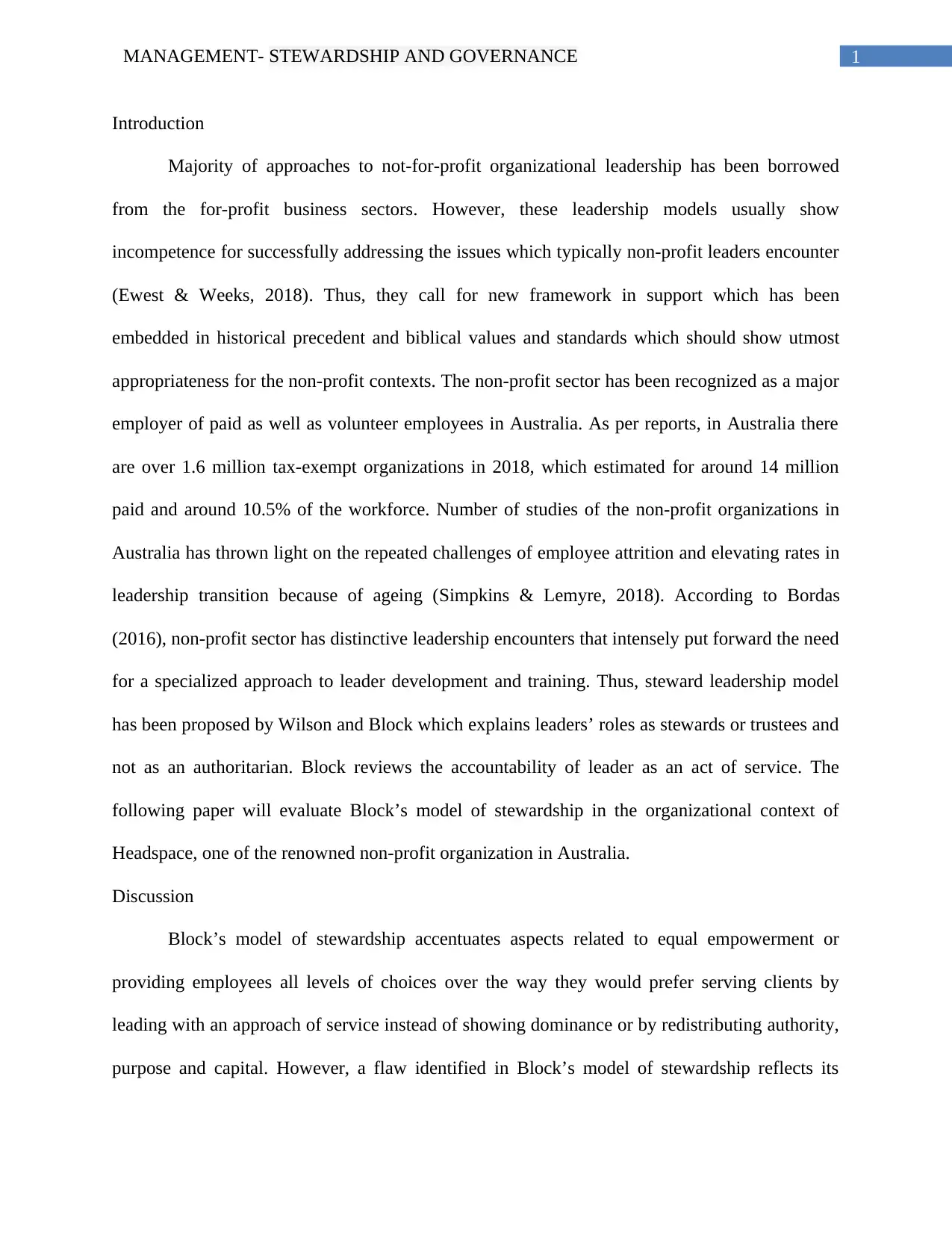
1MANAGEMENT- STEWARDSHIP AND GOVERNANCE
Introduction
Majority of approaches to not-for-profit organizational leadership has been borrowed
from the for-profit business sectors. However, these leadership models usually show
incompetence for successfully addressing the issues which typically non-profit leaders encounter
(Ewest & Weeks, 2018). Thus, they call for new framework in support which has been
embedded in historical precedent and biblical values and standards which should show utmost
appropriateness for the non-profit contexts. The non-profit sector has been recognized as a major
employer of paid as well as volunteer employees in Australia. As per reports, in Australia there
are over 1.6 million tax-exempt organizations in 2018, which estimated for around 14 million
paid and around 10.5% of the workforce. Number of studies of the non-profit organizations in
Australia has thrown light on the repeated challenges of employee attrition and elevating rates in
leadership transition because of ageing (Simpkins & Lemyre, 2018). According to Bordas
(2016), non-profit sector has distinctive leadership encounters that intensely put forward the need
for a specialized approach to leader development and training. Thus, steward leadership model
has been proposed by Wilson and Block which explains leaders’ roles as stewards or trustees and
not as an authoritarian. Block reviews the accountability of leader as an act of service. The
following paper will evaluate Block’s model of stewardship in the organizational context of
Headspace, one of the renowned non-profit organization in Australia.
Discussion
Block’s model of stewardship accentuates aspects related to equal empowerment or
providing employees all levels of choices over the way they would prefer serving clients by
leading with an approach of service instead of showing dominance or by redistributing authority,
purpose and capital. However, a flaw identified in Block’s model of stewardship reflects its
Introduction
Majority of approaches to not-for-profit organizational leadership has been borrowed
from the for-profit business sectors. However, these leadership models usually show
incompetence for successfully addressing the issues which typically non-profit leaders encounter
(Ewest & Weeks, 2018). Thus, they call for new framework in support which has been
embedded in historical precedent and biblical values and standards which should show utmost
appropriateness for the non-profit contexts. The non-profit sector has been recognized as a major
employer of paid as well as volunteer employees in Australia. As per reports, in Australia there
are over 1.6 million tax-exempt organizations in 2018, which estimated for around 14 million
paid and around 10.5% of the workforce. Number of studies of the non-profit organizations in
Australia has thrown light on the repeated challenges of employee attrition and elevating rates in
leadership transition because of ageing (Simpkins & Lemyre, 2018). According to Bordas
(2016), non-profit sector has distinctive leadership encounters that intensely put forward the need
for a specialized approach to leader development and training. Thus, steward leadership model
has been proposed by Wilson and Block which explains leaders’ roles as stewards or trustees and
not as an authoritarian. Block reviews the accountability of leader as an act of service. The
following paper will evaluate Block’s model of stewardship in the organizational context of
Headspace, one of the renowned non-profit organization in Australia.
Discussion
Block’s model of stewardship accentuates aspects related to equal empowerment or
providing employees all levels of choices over the way they would prefer serving clients by
leading with an approach of service instead of showing dominance or by redistributing authority,
purpose and capital. However, a flaw identified in Block’s model of stewardship reflects its
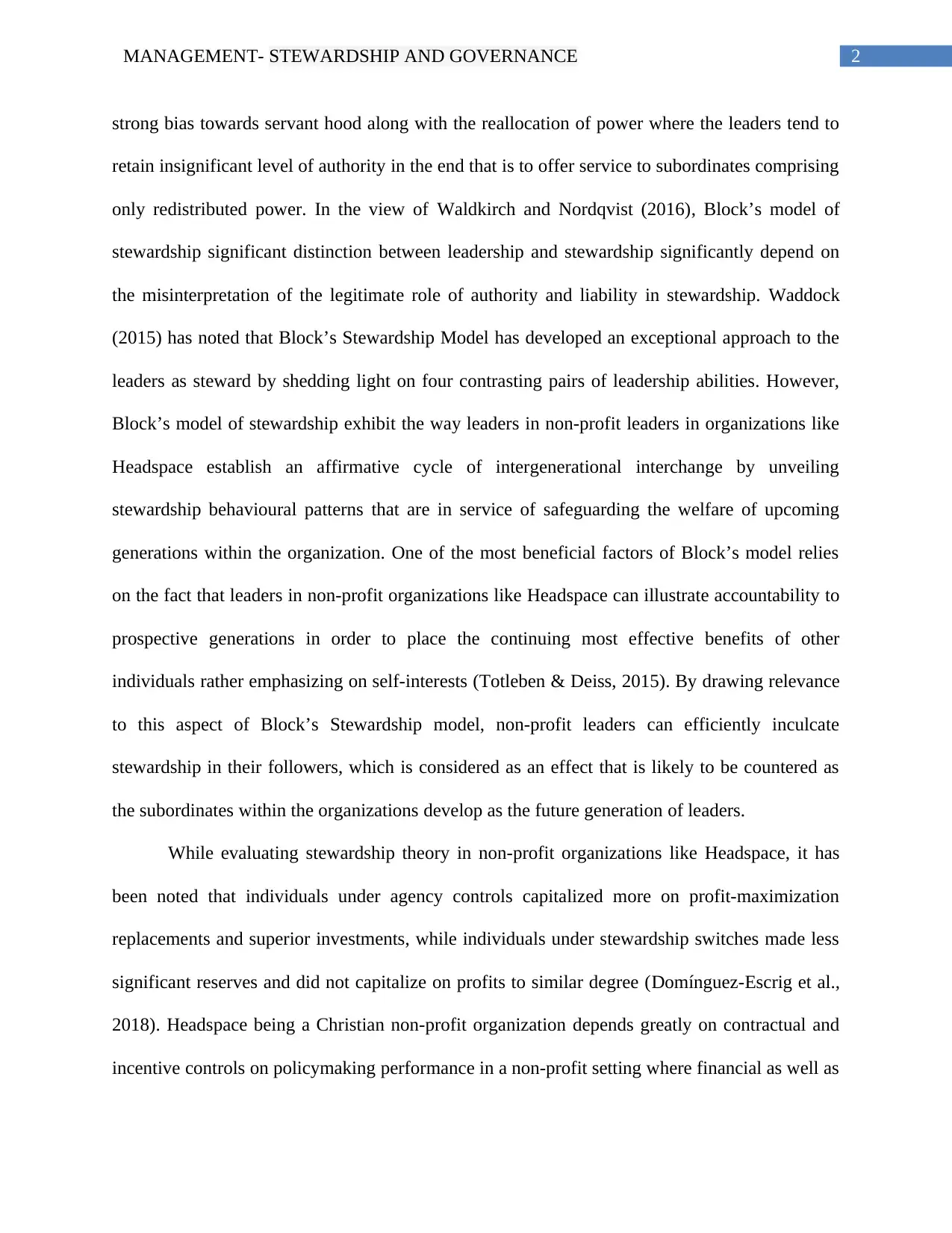
2MANAGEMENT- STEWARDSHIP AND GOVERNANCE
strong bias towards servant hood along with the reallocation of power where the leaders tend to
retain insignificant level of authority in the end that is to offer service to subordinates comprising
only redistributed power. In the view of Waldkirch and Nordqvist (2016), Block’s model of
stewardship significant distinction between leadership and stewardship significantly depend on
the misinterpretation of the legitimate role of authority and liability in stewardship. Waddock
(2015) has noted that Block’s Stewardship Model has developed an exceptional approach to the
leaders as steward by shedding light on four contrasting pairs of leadership abilities. However,
Block’s model of stewardship exhibit the way leaders in non-profit leaders in organizations like
Headspace establish an affirmative cycle of intergenerational interchange by unveiling
stewardship behavioural patterns that are in service of safeguarding the welfare of upcoming
generations within the organization. One of the most beneficial factors of Block’s model relies
on the fact that leaders in non-profit organizations like Headspace can illustrate accountability to
prospective generations in order to place the continuing most effective benefits of other
individuals rather emphasizing on self-interests (Totleben & Deiss, 2015). By drawing relevance
to this aspect of Block’s Stewardship model, non-profit leaders can efficiently inculcate
stewardship in their followers, which is considered as an effect that is likely to be countered as
the subordinates within the organizations develop as the future generation of leaders.
While evaluating stewardship theory in non-profit organizations like Headspace, it has
been noted that individuals under agency controls capitalized more on profit-maximization
replacements and superior investments, while individuals under stewardship switches made less
significant reserves and did not capitalize on profits to similar degree (Domínguez-Escrig et al.,
2018). Headspace being a Christian non-profit organization depends greatly on contractual and
incentive controls on policymaking performance in a non-profit setting where financial as well as
strong bias towards servant hood along with the reallocation of power where the leaders tend to
retain insignificant level of authority in the end that is to offer service to subordinates comprising
only redistributed power. In the view of Waldkirch and Nordqvist (2016), Block’s model of
stewardship significant distinction between leadership and stewardship significantly depend on
the misinterpretation of the legitimate role of authority and liability in stewardship. Waddock
(2015) has noted that Block’s Stewardship Model has developed an exceptional approach to the
leaders as steward by shedding light on four contrasting pairs of leadership abilities. However,
Block’s model of stewardship exhibit the way leaders in non-profit leaders in organizations like
Headspace establish an affirmative cycle of intergenerational interchange by unveiling
stewardship behavioural patterns that are in service of safeguarding the welfare of upcoming
generations within the organization. One of the most beneficial factors of Block’s model relies
on the fact that leaders in non-profit organizations like Headspace can illustrate accountability to
prospective generations in order to place the continuing most effective benefits of other
individuals rather emphasizing on self-interests (Totleben & Deiss, 2015). By drawing relevance
to this aspect of Block’s Stewardship model, non-profit leaders can efficiently inculcate
stewardship in their followers, which is considered as an effect that is likely to be countered as
the subordinates within the organizations develop as the future generation of leaders.
While evaluating stewardship theory in non-profit organizations like Headspace, it has
been noted that individuals under agency controls capitalized more on profit-maximization
replacements and superior investments, while individuals under stewardship switches made less
significant reserves and did not capitalize on profits to similar degree (Domínguez-Escrig et al.,
2018). Headspace being a Christian non-profit organization depends greatly on contractual and
incentive controls on policymaking performance in a non-profit setting where financial as well as
⊘ This is a preview!⊘
Do you want full access?
Subscribe today to unlock all pages.

Trusted by 1+ million students worldwide
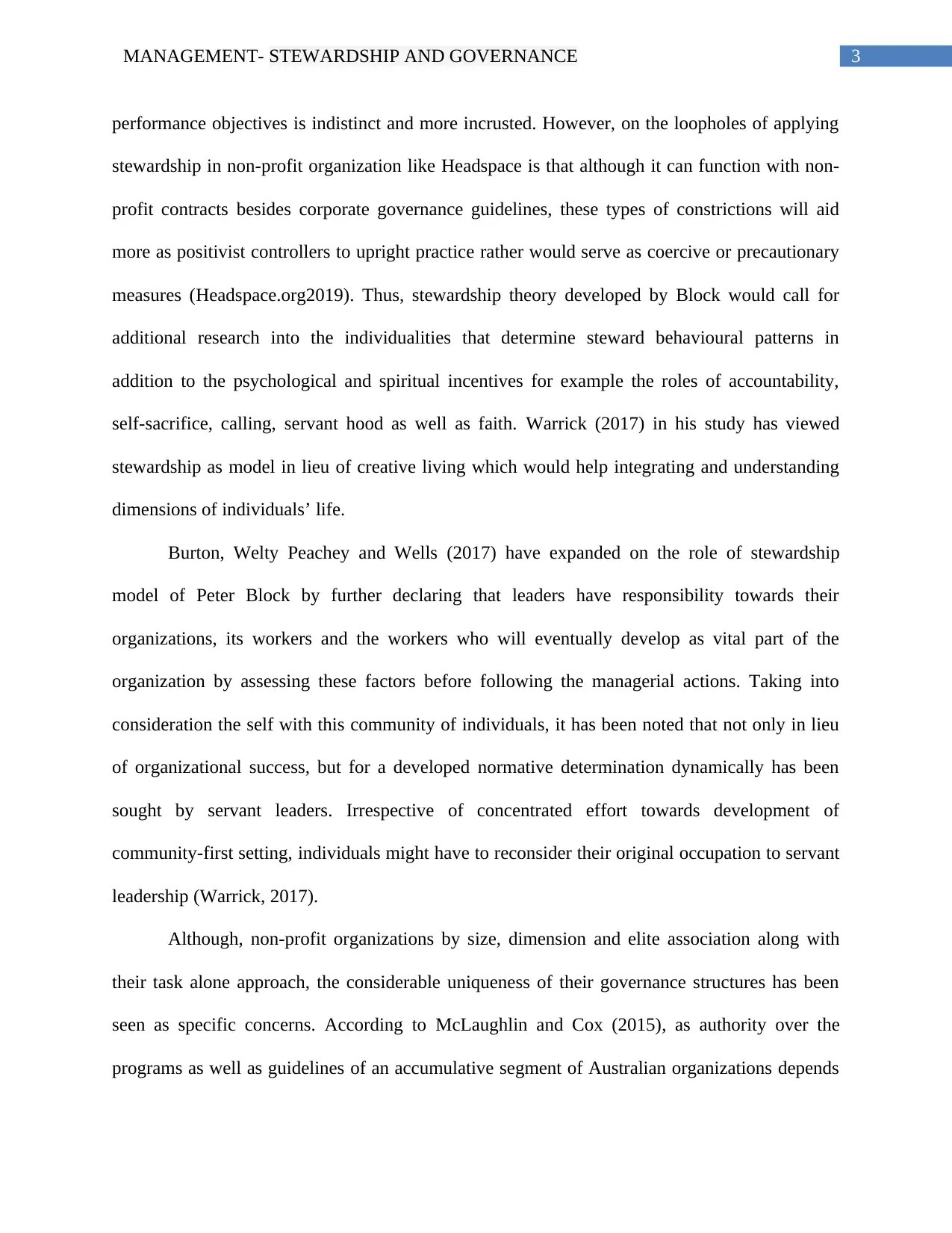
3MANAGEMENT- STEWARDSHIP AND GOVERNANCE
performance objectives is indistinct and more incrusted. However, on the loopholes of applying
stewardship in non-profit organization like Headspace is that although it can function with non-
profit contracts besides corporate governance guidelines, these types of constrictions will aid
more as positivist controllers to upright practice rather would serve as coercive or precautionary
measures (Headspace.org2019). Thus, stewardship theory developed by Block would call for
additional research into the individualities that determine steward behavioural patterns in
addition to the psychological and spiritual incentives for example the roles of accountability,
self-sacrifice, calling, servant hood as well as faith. Warrick (2017) in his study has viewed
stewardship as model in lieu of creative living which would help integrating and understanding
dimensions of individuals’ life.
Burton, Welty Peachey and Wells (2017) have expanded on the role of stewardship
model of Peter Block by further declaring that leaders have responsibility towards their
organizations, its workers and the workers who will eventually develop as vital part of the
organization by assessing these factors before following the managerial actions. Taking into
consideration the self with this community of individuals, it has been noted that not only in lieu
of organizational success, but for a developed normative determination dynamically has been
sought by servant leaders. Irrespective of concentrated effort towards development of
community-first setting, individuals might have to reconsider their original occupation to servant
leadership (Warrick, 2017).
Although, non-profit organizations by size, dimension and elite association along with
their task alone approach, the considerable uniqueness of their governance structures has been
seen as specific concerns. According to McLaughlin and Cox (2015), as authority over the
programs as well as guidelines of an accumulative segment of Australian organizations depends
performance objectives is indistinct and more incrusted. However, on the loopholes of applying
stewardship in non-profit organization like Headspace is that although it can function with non-
profit contracts besides corporate governance guidelines, these types of constrictions will aid
more as positivist controllers to upright practice rather would serve as coercive or precautionary
measures (Headspace.org2019). Thus, stewardship theory developed by Block would call for
additional research into the individualities that determine steward behavioural patterns in
addition to the psychological and spiritual incentives for example the roles of accountability,
self-sacrifice, calling, servant hood as well as faith. Warrick (2017) in his study has viewed
stewardship as model in lieu of creative living which would help integrating and understanding
dimensions of individuals’ life.
Burton, Welty Peachey and Wells (2017) have expanded on the role of stewardship
model of Peter Block by further declaring that leaders have responsibility towards their
organizations, its workers and the workers who will eventually develop as vital part of the
organization by assessing these factors before following the managerial actions. Taking into
consideration the self with this community of individuals, it has been noted that not only in lieu
of organizational success, but for a developed normative determination dynamically has been
sought by servant leaders. Irrespective of concentrated effort towards development of
community-first setting, individuals might have to reconsider their original occupation to servant
leadership (Warrick, 2017).
Although, non-profit organizations by size, dimension and elite association along with
their task alone approach, the considerable uniqueness of their governance structures has been
seen as specific concerns. According to McLaughlin and Cox (2015), as authority over the
programs as well as guidelines of an accumulative segment of Australian organizations depends
Paraphrase This Document
Need a fresh take? Get an instant paraphrase of this document with our AI Paraphraser
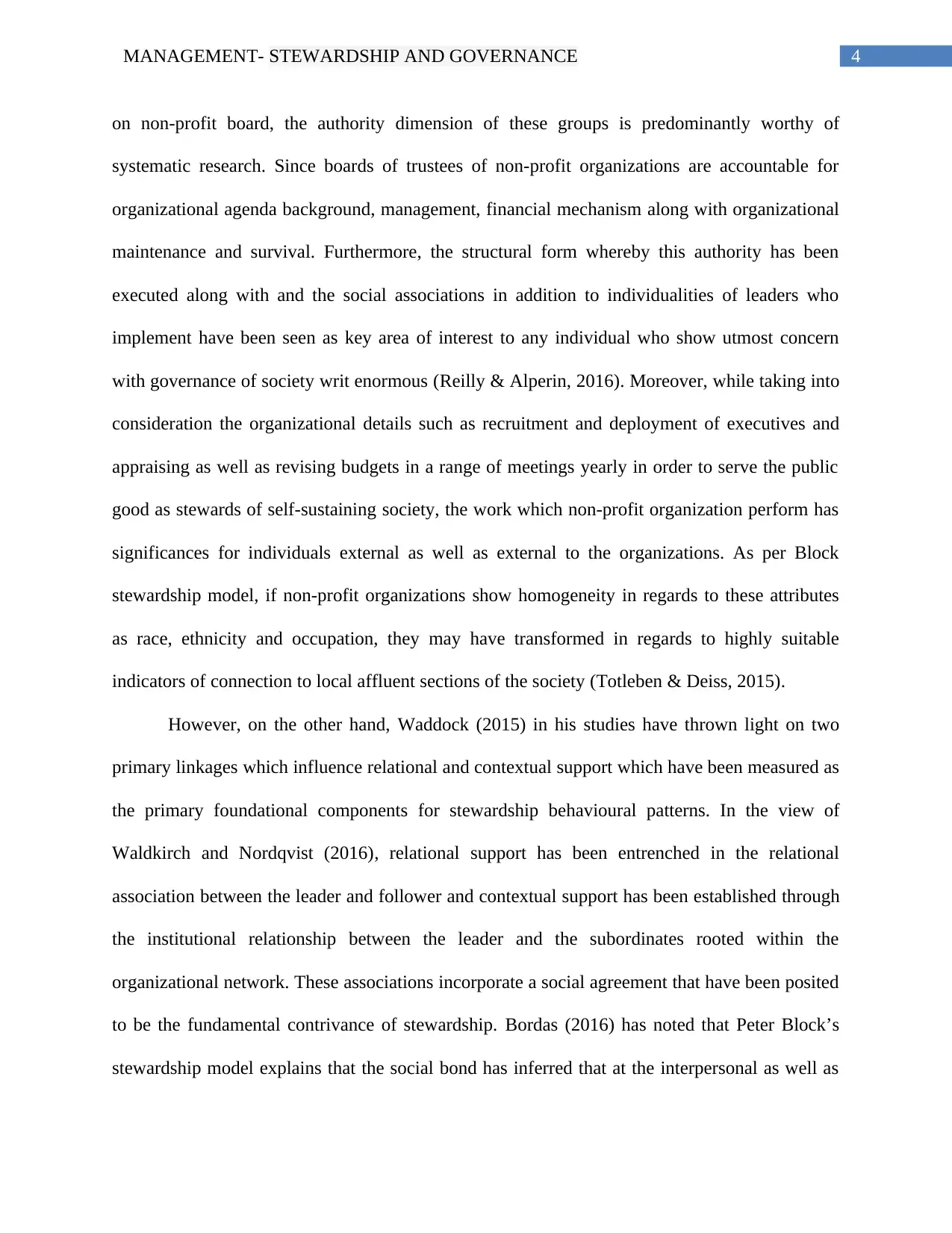
4MANAGEMENT- STEWARDSHIP AND GOVERNANCE
on non-profit board, the authority dimension of these groups is predominantly worthy of
systematic research. Since boards of trustees of non-profit organizations are accountable for
organizational agenda background, management, financial mechanism along with organizational
maintenance and survival. Furthermore, the structural form whereby this authority has been
executed along with and the social associations in addition to individualities of leaders who
implement have been seen as key area of interest to any individual who show utmost concern
with governance of society writ enormous (Reilly & Alperin, 2016). Moreover, while taking into
consideration the organizational details such as recruitment and deployment of executives and
appraising as well as revising budgets in a range of meetings yearly in order to serve the public
good as stewards of self-sustaining society, the work which non-profit organization perform has
significances for individuals external as well as external to the organizations. As per Block
stewardship model, if non-profit organizations show homogeneity in regards to these attributes
as race, ethnicity and occupation, they may have transformed in regards to highly suitable
indicators of connection to local affluent sections of the society (Totleben & Deiss, 2015).
However, on the other hand, Waddock (2015) in his studies have thrown light on two
primary linkages which influence relational and contextual support which have been measured as
the primary foundational components for stewardship behavioural patterns. In the view of
Waldkirch and Nordqvist (2016), relational support has been entrenched in the relational
association between the leader and follower and contextual support has been established through
the institutional relationship between the leader and the subordinates rooted within the
organizational network. These associations incorporate a social agreement that have been posited
to be the fundamental contrivance of stewardship. Bordas (2016) has noted that Peter Block’s
stewardship model explains that the social bond has inferred that at the interpersonal as well as
on non-profit board, the authority dimension of these groups is predominantly worthy of
systematic research. Since boards of trustees of non-profit organizations are accountable for
organizational agenda background, management, financial mechanism along with organizational
maintenance and survival. Furthermore, the structural form whereby this authority has been
executed along with and the social associations in addition to individualities of leaders who
implement have been seen as key area of interest to any individual who show utmost concern
with governance of society writ enormous (Reilly & Alperin, 2016). Moreover, while taking into
consideration the organizational details such as recruitment and deployment of executives and
appraising as well as revising budgets in a range of meetings yearly in order to serve the public
good as stewards of self-sustaining society, the work which non-profit organization perform has
significances for individuals external as well as external to the organizations. As per Block
stewardship model, if non-profit organizations show homogeneity in regards to these attributes
as race, ethnicity and occupation, they may have transformed in regards to highly suitable
indicators of connection to local affluent sections of the society (Totleben & Deiss, 2015).
However, on the other hand, Waddock (2015) in his studies have thrown light on two
primary linkages which influence relational and contextual support which have been measured as
the primary foundational components for stewardship behavioural patterns. In the view of
Waldkirch and Nordqvist (2016), relational support has been entrenched in the relational
association between the leader and follower and contextual support has been established through
the institutional relationship between the leader and the subordinates rooted within the
organizational network. These associations incorporate a social agreement that have been posited
to be the fundamental contrivance of stewardship. Bordas (2016) has noted that Peter Block’s
stewardship model explains that the social bond has inferred that at the interpersonal as well as
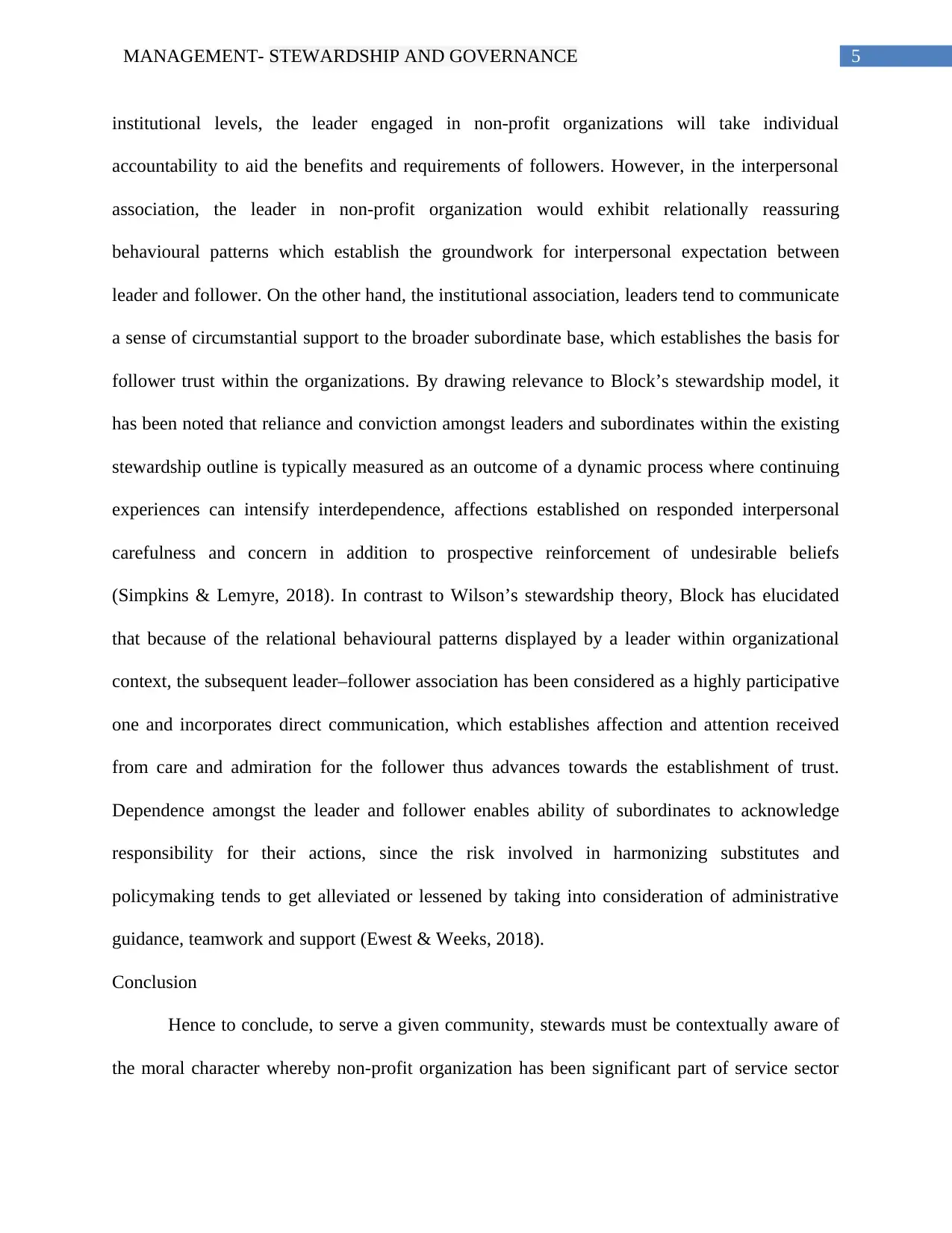
5MANAGEMENT- STEWARDSHIP AND GOVERNANCE
institutional levels, the leader engaged in non-profit organizations will take individual
accountability to aid the benefits and requirements of followers. However, in the interpersonal
association, the leader in non-profit organization would exhibit relationally reassuring
behavioural patterns which establish the groundwork for interpersonal expectation between
leader and follower. On the other hand, the institutional association, leaders tend to communicate
a sense of circumstantial support to the broader subordinate base, which establishes the basis for
follower trust within the organizations. By drawing relevance to Block’s stewardship model, it
has been noted that reliance and conviction amongst leaders and subordinates within the existing
stewardship outline is typically measured as an outcome of a dynamic process where continuing
experiences can intensify interdependence, affections established on responded interpersonal
carefulness and concern in addition to prospective reinforcement of undesirable beliefs
(Simpkins & Lemyre, 2018). In contrast to Wilson’s stewardship theory, Block has elucidated
that because of the relational behavioural patterns displayed by a leader within organizational
context, the subsequent leader–follower association has been considered as a highly participative
one and incorporates direct communication, which establishes affection and attention received
from care and admiration for the follower thus advances towards the establishment of trust.
Dependence amongst the leader and follower enables ability of subordinates to acknowledge
responsibility for their actions, since the risk involved in harmonizing substitutes and
policymaking tends to get alleviated or lessened by taking into consideration of administrative
guidance, teamwork and support (Ewest & Weeks, 2018).
Conclusion
Hence to conclude, to serve a given community, stewards must be contextually aware of
the moral character whereby non-profit organization has been significant part of service sector
institutional levels, the leader engaged in non-profit organizations will take individual
accountability to aid the benefits and requirements of followers. However, in the interpersonal
association, the leader in non-profit organization would exhibit relationally reassuring
behavioural patterns which establish the groundwork for interpersonal expectation between
leader and follower. On the other hand, the institutional association, leaders tend to communicate
a sense of circumstantial support to the broader subordinate base, which establishes the basis for
follower trust within the organizations. By drawing relevance to Block’s stewardship model, it
has been noted that reliance and conviction amongst leaders and subordinates within the existing
stewardship outline is typically measured as an outcome of a dynamic process where continuing
experiences can intensify interdependence, affections established on responded interpersonal
carefulness and concern in addition to prospective reinforcement of undesirable beliefs
(Simpkins & Lemyre, 2018). In contrast to Wilson’s stewardship theory, Block has elucidated
that because of the relational behavioural patterns displayed by a leader within organizational
context, the subsequent leader–follower association has been considered as a highly participative
one and incorporates direct communication, which establishes affection and attention received
from care and admiration for the follower thus advances towards the establishment of trust.
Dependence amongst the leader and follower enables ability of subordinates to acknowledge
responsibility for their actions, since the risk involved in harmonizing substitutes and
policymaking tends to get alleviated or lessened by taking into consideration of administrative
guidance, teamwork and support (Ewest & Weeks, 2018).
Conclusion
Hence to conclude, to serve a given community, stewards must be contextually aware of
the moral character whereby non-profit organization has been significant part of service sector
⊘ This is a preview!⊘
Do you want full access?
Subscribe today to unlock all pages.

Trusted by 1+ million students worldwide
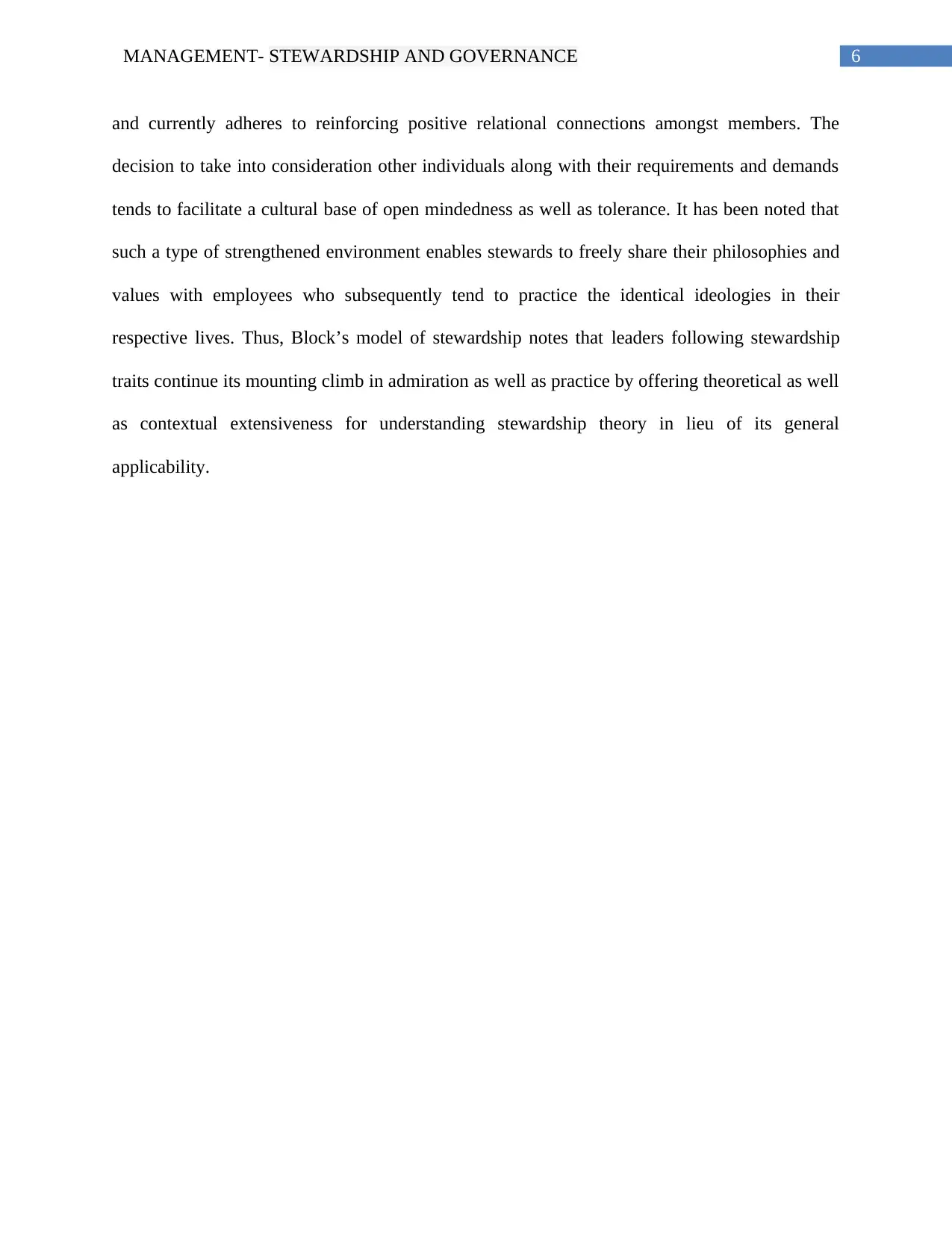
6MANAGEMENT- STEWARDSHIP AND GOVERNANCE
and currently adheres to reinforcing positive relational connections amongst members. The
decision to take into consideration other individuals along with their requirements and demands
tends to facilitate a cultural base of open mindedness as well as tolerance. It has been noted that
such a type of strengthened environment enables stewards to freely share their philosophies and
values with employees who subsequently tend to practice the identical ideologies in their
respective lives. Thus, Block’s model of stewardship notes that leaders following stewardship
traits continue its mounting climb in admiration as well as practice by offering theoretical as well
as contextual extensiveness for understanding stewardship theory in lieu of its general
applicability.
and currently adheres to reinforcing positive relational connections amongst members. The
decision to take into consideration other individuals along with their requirements and demands
tends to facilitate a cultural base of open mindedness as well as tolerance. It has been noted that
such a type of strengthened environment enables stewards to freely share their philosophies and
values with employees who subsequently tend to practice the identical ideologies in their
respective lives. Thus, Block’s model of stewardship notes that leaders following stewardship
traits continue its mounting climb in admiration as well as practice by offering theoretical as well
as contextual extensiveness for understanding stewardship theory in lieu of its general
applicability.
Paraphrase This Document
Need a fresh take? Get an instant paraphrase of this document with our AI Paraphraser
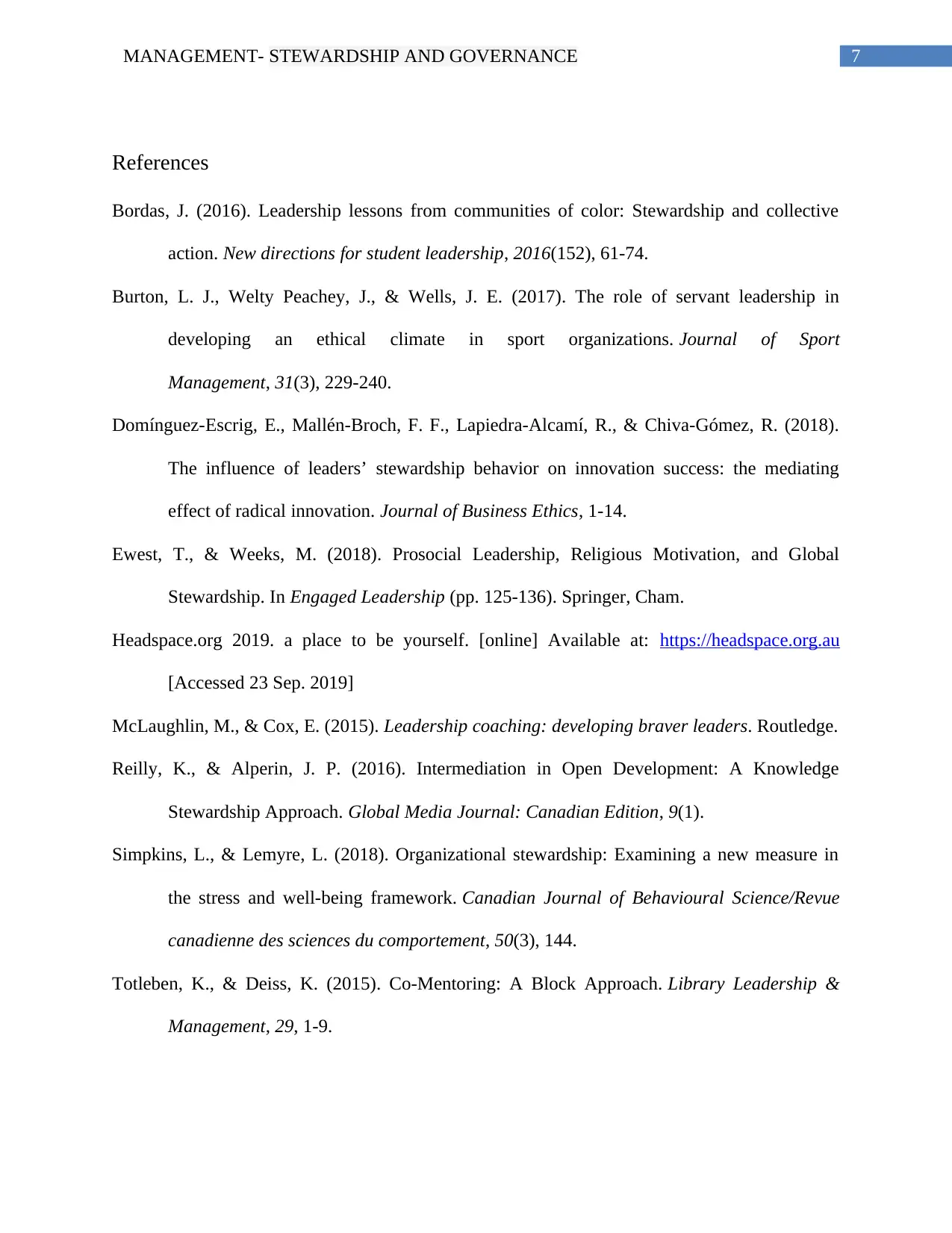
7MANAGEMENT- STEWARDSHIP AND GOVERNANCE
References
Bordas, J. (2016). Leadership lessons from communities of color: Stewardship and collective
action. New directions for student leadership, 2016(152), 61-74.
Burton, L. J., Welty Peachey, J., & Wells, J. E. (2017). The role of servant leadership in
developing an ethical climate in sport organizations. Journal of Sport
Management, 31(3), 229-240.
Domínguez-Escrig, E., Mallén-Broch, F. F., Lapiedra-Alcamí, R., & Chiva-Gómez, R. (2018).
The influence of leaders’ stewardship behavior on innovation success: the mediating
effect of radical innovation. Journal of Business Ethics, 1-14.
Ewest, T., & Weeks, M. (2018). Prosocial Leadership, Religious Motivation, and Global
Stewardship. In Engaged Leadership (pp. 125-136). Springer, Cham.
Headspace.org 2019. a place to be yourself. [online] Available at: https://headspace.org.au
[Accessed 23 Sep. 2019]
McLaughlin, M., & Cox, E. (2015). Leadership coaching: developing braver leaders. Routledge.
Reilly, K., & Alperin, J. P. (2016). Intermediation in Open Development: A Knowledge
Stewardship Approach. Global Media Journal: Canadian Edition, 9(1).
Simpkins, L., & Lemyre, L. (2018). Organizational stewardship: Examining a new measure in
the stress and well-being framework. Canadian Journal of Behavioural Science/Revue
canadienne des sciences du comportement, 50(3), 144.
Totleben, K., & Deiss, K. (2015). Co-Mentoring: A Block Approach. Library Leadership &
Management, 29, 1-9.
References
Bordas, J. (2016). Leadership lessons from communities of color: Stewardship and collective
action. New directions for student leadership, 2016(152), 61-74.
Burton, L. J., Welty Peachey, J., & Wells, J. E. (2017). The role of servant leadership in
developing an ethical climate in sport organizations. Journal of Sport
Management, 31(3), 229-240.
Domínguez-Escrig, E., Mallén-Broch, F. F., Lapiedra-Alcamí, R., & Chiva-Gómez, R. (2018).
The influence of leaders’ stewardship behavior on innovation success: the mediating
effect of radical innovation. Journal of Business Ethics, 1-14.
Ewest, T., & Weeks, M. (2018). Prosocial Leadership, Religious Motivation, and Global
Stewardship. In Engaged Leadership (pp. 125-136). Springer, Cham.
Headspace.org 2019. a place to be yourself. [online] Available at: https://headspace.org.au
[Accessed 23 Sep. 2019]
McLaughlin, M., & Cox, E. (2015). Leadership coaching: developing braver leaders. Routledge.
Reilly, K., & Alperin, J. P. (2016). Intermediation in Open Development: A Knowledge
Stewardship Approach. Global Media Journal: Canadian Edition, 9(1).
Simpkins, L., & Lemyre, L. (2018). Organizational stewardship: Examining a new measure in
the stress and well-being framework. Canadian Journal of Behavioural Science/Revue
canadienne des sciences du comportement, 50(3), 144.
Totleben, K., & Deiss, K. (2015). Co-Mentoring: A Block Approach. Library Leadership &
Management, 29, 1-9.
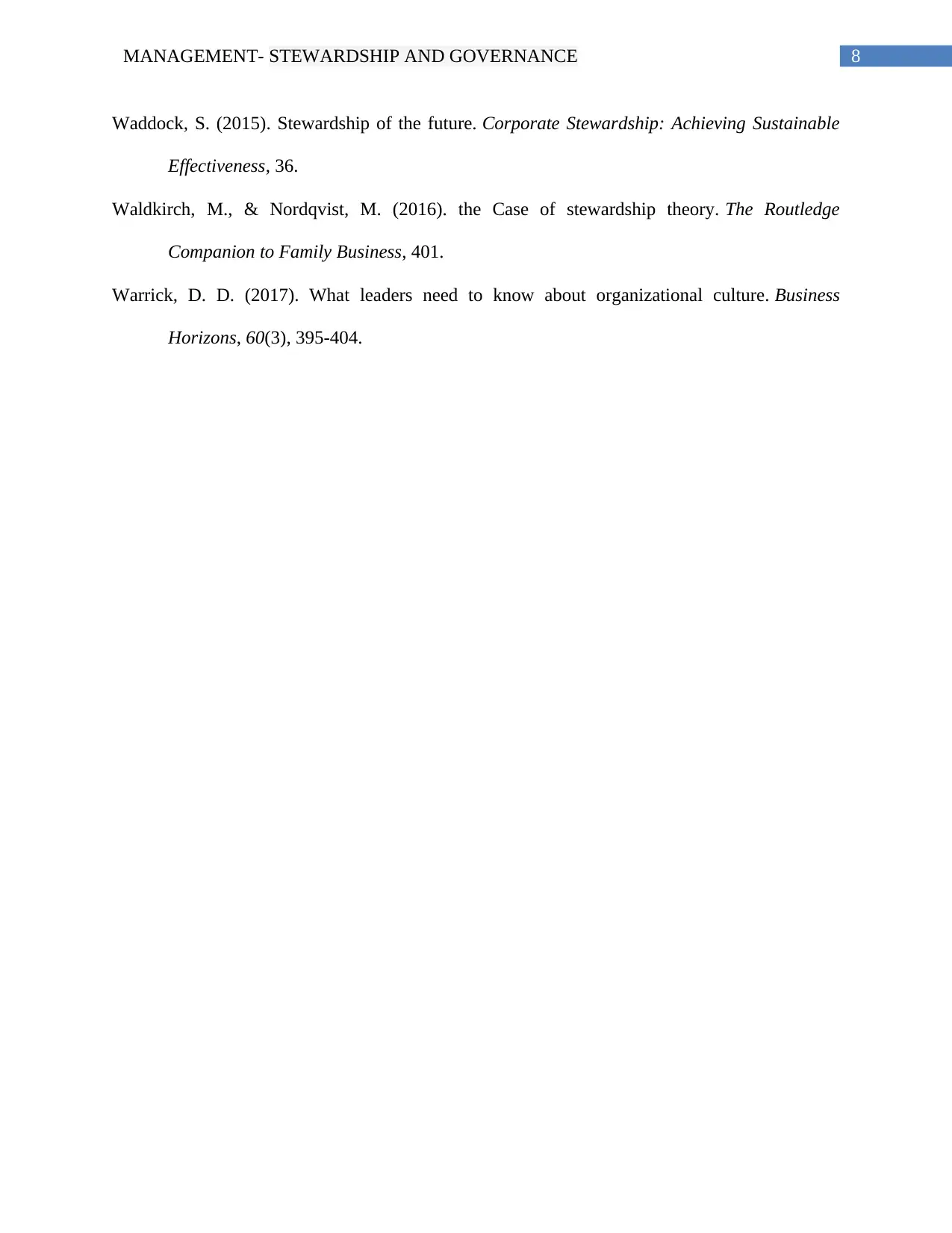
8MANAGEMENT- STEWARDSHIP AND GOVERNANCE
Waddock, S. (2015). Stewardship of the future. Corporate Stewardship: Achieving Sustainable
Effectiveness, 36.
Waldkirch, M., & Nordqvist, M. (2016). the Case of stewardship theory. The Routledge
Companion to Family Business, 401.
Warrick, D. D. (2017). What leaders need to know about organizational culture. Business
Horizons, 60(3), 395-404.
Waddock, S. (2015). Stewardship of the future. Corporate Stewardship: Achieving Sustainable
Effectiveness, 36.
Waldkirch, M., & Nordqvist, M. (2016). the Case of stewardship theory. The Routledge
Companion to Family Business, 401.
Warrick, D. D. (2017). What leaders need to know about organizational culture. Business
Horizons, 60(3), 395-404.
⊘ This is a preview!⊘
Do you want full access?
Subscribe today to unlock all pages.

Trusted by 1+ million students worldwide
1 out of 9
Related Documents
Your All-in-One AI-Powered Toolkit for Academic Success.
+13062052269
info@desklib.com
Available 24*7 on WhatsApp / Email
![[object Object]](/_next/static/media/star-bottom.7253800d.svg)
Unlock your academic potential
Copyright © 2020–2025 A2Z Services. All Rights Reserved. Developed and managed by ZUCOL.





